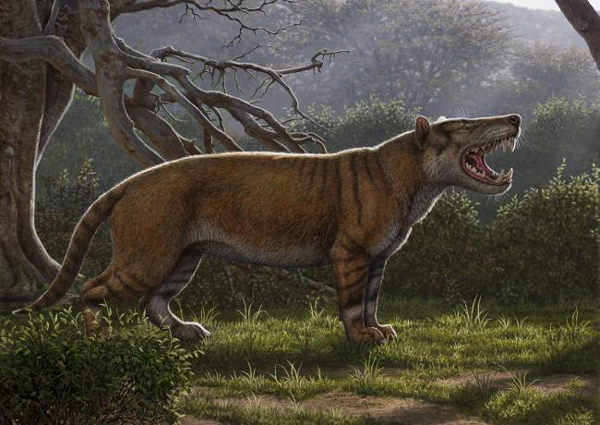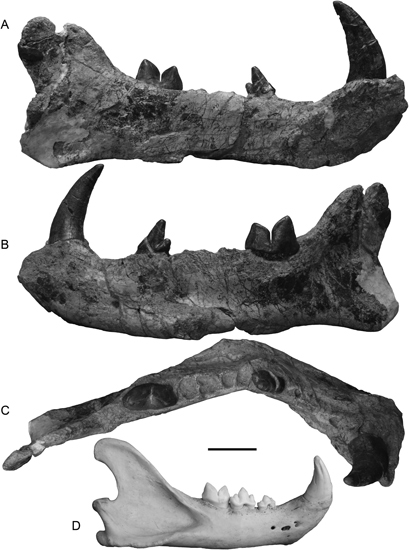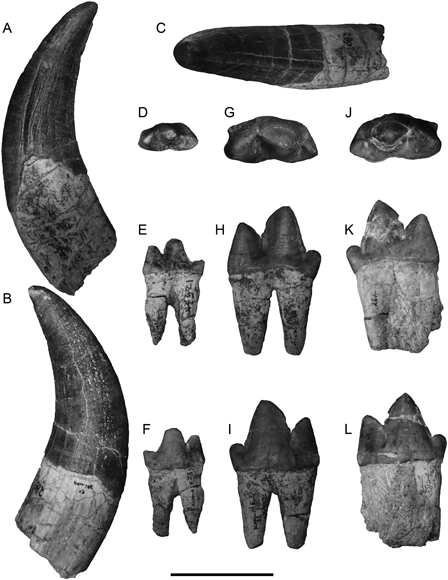Simbakubwa kutokaafrika – Giant African Hyaenodont
Scientists writing in the “Journal of Vertebrate Paleontology” have described a new species of giant hyaenodont from sub-Saharan Africa that was bigger than a polar bear. The giant carnivore, most likely the apex predator in its Early Miocene ecosystem, has been named Simbakubwa kutokaafrika and this fearsome beast with its huge teeth is the stuff of nightmares.
A Life Reconstruction of the Newly Described Giant Hyaenodont Simbakubwa kutokaafrika
Picture credit: Mauricio Anton
Simbakubwa kutokaafrika – A Chance Discovery
Co-author of the scientific paper Matthew Borths (Duke University, North Carolina), was visiting the Nairobi National Museum in Kenya in 2013 to view some specimens. He asked to view the contents of a collection labelled as “hyaenas” and he discovered a gigantic lower jaw bone more than forty centimetres in length. The bones and teeth had been placed in a drawer after a dig in western Kenya in the late 1970s and had remained there ever since.
The genus name, Simbakubwa is from Swahili “simba” meaning “lion” and “kubwa” meaning “big”, big this animal certainly was, its body weight has been estimated at over 1,500 kilograms making S. kutokaafrika heavier than the largest land carnivore alive today, the polar bear (Ursus maritimus). The species name kutokaafrika, is also from Swahili, it means “from Africa”.
The Lower Jaw of S. kutokaafrika Compared to the Jaw of a Modern Lion (Panthero leo)
Picture credit: Journal of Vertebrate Paleontology
The picture (above), shows the holotype left dentary (KNM-ME 20A), in (A) lingual, (B) buccal and (C) occlusal views. It is compared in size to the lower jaw of a modern lion (Panthero leo), photograph (D). Note the scale bar is 5 cm.
Classified as a Member of the Hyaenodonta (Hyainailourinae)
The carnivore has been classified as a member of the Hyaenodonta (Hyainailourinae), a large and diverse group of creodonts that may have evolved in Africa. These animals dominated predatory niches in ecosystems until the emergence of the modern Carnivora. As such, Simbakubwa is only very distantly related to today’s big cats the Felidae.
The Giant Teeth of a Giant Prehistoric Predator
Picture credit: Journal of Vertebrate Palaeontology
The photograph (above), shows isolated teeth associated with the lower jaw. Pictures (A, B and C) show a right lower canine in lingual, buccal and occlusal views. A right molar (m1), is shown in (D) occlusal, (E) lingual and (F) buccal views and the second right molar (m2), is shown in (G) occlusal, (H) lingual and (I) buccal views, whilst a left molar (m2), is show in (J) occlusal, (K) lingual and (L) buccal views. Note the scale bar equals 5 cm.
A Widely Dispersed Clade of Super-sized Mammalian Predators
The hyainailourine hyaenodonts are among the biggest land mammalian carnivores known to science. The group is temporally and geographically widely dispersed with fossil finds in Europe, Asia, North America, Arabia as well as Africa. The fossil material assigned to the Simbakubwa genus represent the most complete hyainailourine known from sub-Saharan Africa. The researchers conclude that the fossils represent a relatively young adult animal and the material was collected at the Meswa Bridge site (western Kenya).
Bayesian ancestral state reconstruction supports an Afro-Arabian origin for Hyainailourinae with subsequent dispersal to Europe and Asia. A regression analysis conducted by the authors of the paper, based on carnassial size suggests that Simbakubwa could have weighed around 1,500 kilogrammes, more than four times the weight of a modern African lion. The evolution and extinction of Hyainailourinae offers important insights for interpreting ecological transitions from Paleogene to Neogene faunas in Afro-Arabia and Eurasia.
The scientific paper: “Simbakubwa kutokaafrika, gen. et sp. nov. (Hyainailourinae, Hyaenodonta, ‘Creodonta,’ Mammalia), a gigantic carnivore from the earliest Miocene of Kenya” by Matthew R. Borths and Nancy J. Stevens published in the Journal of Vertebrate Paleontology.
For models and replicas of prehistoric animals: The Everything Dinosaur Website.









Leave A Comment